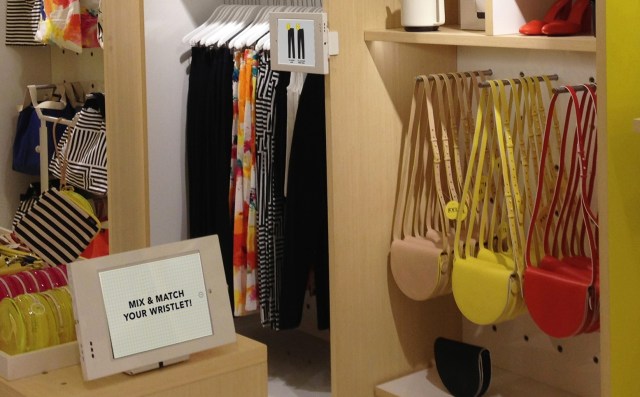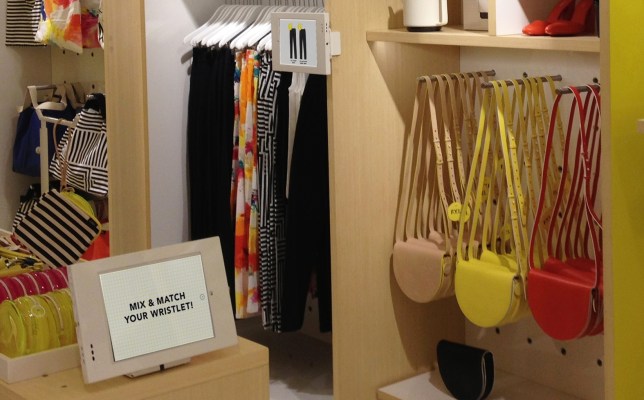Yesterday, Apple began a small press push on its new iBeacon technology, pushed an Apple Store app update to support them and turned the feature on in 254 U.S.-based stores in an initial rollout. According to the details we know so far, some Apple stores may have as many as 20 iBeacons deployed, depending on the size.
But the size of that rollout is deceptive for a couple of reasons — and the full implications of the impact on Apple’s iPad business, the internal mapping industry and the retail market are far bigger than anyone has really copped to.
Specifically, most of the coverage of iBeacons so far has failed to recognize a very important reality of this system: every iOS device since the iPhone 4s and iPad 3rd gen is already capable of being either an iBeacon receiver or transmitter, as long as it’s properly configured.
Yes, there are separate devices like Estimote’s beacons that can use Bluetooth LE protocols to act as a beacon, and Apple is using separate, specialized iBeacon devices that look like small silver rectangles tucked under shelves in some stores.
But some of the iBeacons deployed in Apple stores are not specialized hardware at all, they’re just regular iPads or iPhones that have been configured as iBeacons. And that capability extends to any Apple device with Bluetooth Low Energy and the latest major version of iOS. Let that sink in for a minute and you’ll start to realize the forward-thinking strategy Apple has been implementing over the course of the last few years.
According to estimates by Creative Strategies Analyst and Techpinions columnist Ben Bajarin, an estimated 170-190 million iOS devices are currently capable of being iBeacons — that is they have the right hardware and are running iOS 7. That number could swell to 250 million if holiday sales of iPhones and iPads are strong. Bajarin notes that Apple’s anticipated China Mobile deal could put them over 200 million in iPhone sales in 2014 alone.
This means that every compatible iPad currently deployed in a retail store is already capable of being configured as an iBeacon transmitter — and every iOS device with Bluetooth LE can be a receiver. And the iPad is already enormously dominant in the retail space. We spoke to Scott Paul, CEO of ArmorActive — a tablet enclosure solutions company — about their deployments of iPads and other tablets as digital signage, kiosks, information panels and more.
Some 90 percent of ArmorActive’s sales involve iPads, 88 percent of its customers are using iOS, 10 percent use Android, and only 2 percent are on Windows devices. The company has been installing iPad solutions since late 2010, when the iPad was launched. They handled the installation of iPads in Kate Spade stores that made a splash earlier this year. To date, they’ve deployed nearly 50,000 tablet kiosks in hotels, restaurants, retail and other locations. Paul says that they have seen demand for Android tablets wax and wane, as ‘hot’ models like the Nexus 7 have hit the market.

“Apple continues to be the tablet of choice for the majority of kiosk use that we build at ArmorActive,” Paul told TechCrunch. “Android is there, but we find that even though the price can be more competitive, the [fragmented] versioning of the OS and change in size makes it difficult to rely on the device for long-term deployments. Microsoft has been gaining traction with the larger enterprise clients because of IT being familiar with the OS.”
Microsoft, a surprise recent dark horse in the retail tablet install market, has gained a lot of attention in the space because clients are familiar with integrating them into their infrastructure, says Paul. Remote management of these Windows tablets is also far more flexible and powerful than Apple’s iPad solutions. Apple does iterate on its remote utilities over time, but it’s far outstripped by the administration capabilities of Windows-based tablets. If, Paul says, there was a stronger app development community, Microsoft would be seeing even greater traction.
We asked Paul about the implications for the retail tablet install business if currently installed iPads can be used as iBeacons. While he was aware of the iBeacon system, and Apple’s rollout today, he was surprised to learn that existing hardware could also be used as an iBeacon.
“This would present a major advantage to Apple, as many businesses have already implemented these devices into some part of their business, so iBeacons could essentially be turned on all over the business landscape with just a little education and awareness,” Paul told us. “This would further the value of using tablets in retail, as they can both display and transmit messages to those who have displays in their pocket. Apple would widen the gap between themselves and other tablet manufactures, because now their existing hardware plays nicely with your iPhone or iPad and would require such close proximity to make a handshake. NFC has failed to provide this value as evident in the ISYS hardware rollouts that see little adoption.”
Paul notes that the Kate Spade installation — which consists of simple digital signage displays — could be made into something much more powerful if they were turned into iBeacons. And, of course, ArmorActive is just one of many, many companies providing iPad solutions for stores. Another high-profile install is at LeBron James’ Unknwn in Miami, where every shoe has its own iPad display.
Apple’s current implementation of the Apple Store app sketches out the way that most of these experiences will be enabled. Whether the retailer you’re visiting is using a third-party iBeacon or an iPad configured as an iBeacon, you’ll have to have an app from the company on your device. When you installed that app (say the Walmart shopping app) you would have been required to allow it access to your location. So this will be an ‘opt in’ system of sorts.
Once the app is installed and iBeacons are configured, retailers will be able to push ‘micro-location’-based alerts to shoppers about deals or particular sections of the store. The beacons do this by using ‘ranging’ based on Bluetooth signal strength to determine very accurately — within a couple of feet at times — your physical location. These behaviors are impossible with GPS, which isn’t so hot indoors and whose accuracy has a much larger dead zone.
This will be the next big frontier for indoor mapping and retail, and Apple has an enormous — possibly insurmountable — head start because of how forward-thinking it was with Bluetooth LE hardware.
![]()
And these kinds of behaviors were things Apple was thinking about long before it began installing Bluetooth LE in its devices. Current Tesla User Interface designer and former Apple employee Kevin Chang noted that the Apple Store app team had been wanting to implement this kind of thing since they first began working on the app, and it was just now coming to fruition. The first version of the app was shipped in June of 2010, and was likely in planning well before that. Only the latest version of the app finally adds support for iBeacons, which trigger based on various areas of the store.
The current behaviors of the app, we understand, are very limited in comparison to the company’s eventual plans. And Apple’s rollout in its stores is best to be seen as a template on which others — and Apple itself — can build, rather than the end of this thread.
The difference maker to me here is that any sort of indoor or micro-location system now has to battle upstream from demonstration to proof-of-concept to acceptance to licensing and/or acquisition. Apple, by rolling out hundreds of millions of units capable of being both users and active transmitters, has positioned itself to be the de facto standard.
On the other hand, it’s also done the industry a big favor by helping to define what a micro-location system should look and work like — and to do the job of beginning to educate customers.
It’s far too early in the micro-location game to figure out who a ‘winner’ might be, but Apple has already established its hardware as a must for any new systems to either integrate or support.
This isn’t Apple rolling out beacons in a few of its stores. It’s Apple rolling out potential beacons in every store that has an iPad — and there are hundreds of thousands already out there. Now, when a retailer makes a decision about tablet kiosks or signage, they’ve got the incentive of a hyperlocal advertising or customer-service system built right in.
Lest we forget about Apple being a hardware company: This is going to end up selling an absolute ton of iPads.
Screenshots via Macrumors, Unknwn Instagram
